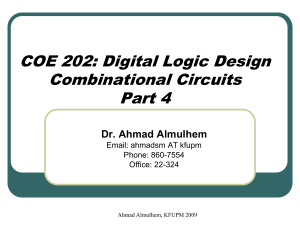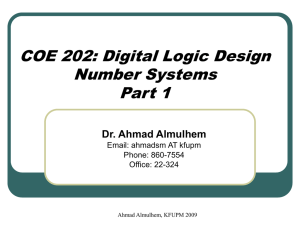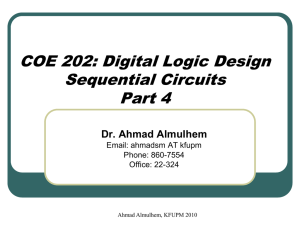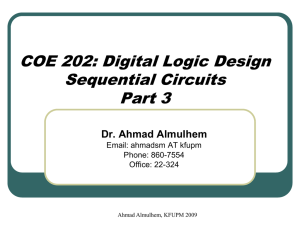ppt
advertisement
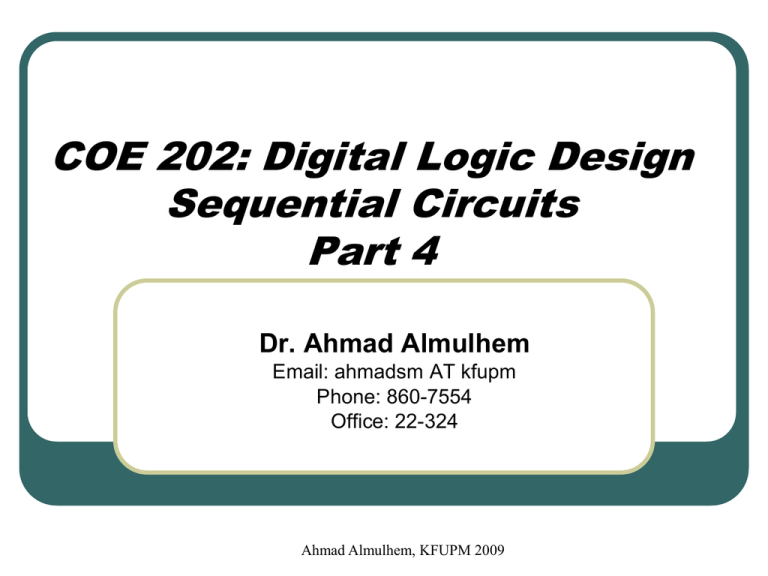
COE 202: Digital Logic Design Sequential Circuits Part 4 Dr. Ahmad Almulhem Email: ahmadsm AT kfupm Phone: 860-7554 Office: 22-324 Ahmad Almulhem, KFUPM 2009 Objectives • Registers • Shift Registers • Ripple Counters Ahmad Almulhem, KFUPM 2009 Registers 0 1 … n-1 • A register is a group of flip-flops. • An n-bit register is made of n flip-flips and can store n bits • A register may have additional combinational gates to perform certain operations Ahmad Almulhem, KFUPM 2009 4-Bit Register • A simple 4-bit register can be made with 4 D-FF • Common Clock • At each positive-edge, 4 bits are loaded in parallel • Previous data is overwritten • Common Clear • Asynchronous clear • When Clear = 0, all FFs are cleared; i.e. 0 is stored. Ahmad Almulhem, KFUPM 2009 4-Bit Register (cont.) Question: How to modify this register to enable/disable loading new data (overwriting previous) ? Ahmad Almulhem, KFUPM 2009 4-Bit Register (cont.) Question: How to modify this register to enable/disable loading new data (overwriting previous) ? Answer: When Load=0, the clock input to the FFs will never take a transition (0 to 1, 1 to 0), no new data will be loaded. When Load=1, normal data loading takes place This is called clock gating Ahmad Almulhem, KFUPM 2009 4-Bit Register (cont.) Clock Skew Problem: It results from clock gating. Ahmad Almulhem, KFUPM 2009 4-Bit Register (cont.) Better Solution: Register with Parallel Load Use a 2x1 MUX as shown: Ahmad Almulhem, KFUPM 2009 4-Bit Register (cont.) A 4-bit Parallel Load Register When Load = 0, the data is not changed (no loading) When Load = 1, the data is loaded in parallel at the rising edge (+ve) load clock Ahmad Almulhem, KFUPM 2009 Shift Registers 0 1 … n-1 • A shift register is a register which shifts its content (right, left, or both) • Made of flip-flops with common clock • Useful to load data serially Ahmad Almulhem, KFUPM 2009 4-bit Shift Register • A simple 4-bit shift register can be made with 4 D-FF • Common Clock • At each positive-edge, 1 bit is shifted in • Rightmost bit is discarded • Which direction this register is shifting? Ahmad Almulhem, KFUPM 2009 Using Shift Register (Examples) Serial Addition Ahmad Almulhem, KFUPM 2009 Using Shift Register (Examples) Serial Transfer between two registers Ahmad Almulhem, KFUPM 2009 Universal Shift Register Question: Design a Universal Shift Register with the following capabilities: • A clear control to clear the register to 0 • A clock to synchronize the operations • A shift-right control (associated with serial in/out) • A shift-left control (associated with serial in/out) • A parallel-load control (to parallel load n bits) • n-parallel output lines • A control signal to leave register unchanged Ahmad Almulhem, KFUPM 2009 Universal Shift Register (cont.) Ahmad Almulhem, KFUPM 2009 Universal Shift Register (cont.) How does it work? • 4 D-FF and 4 MUXs with selection S0,S1 • S0S1=00, FF output is feedback to its input • S0S1=01, A FF input is from left FF or serialin (shift-right) • S0S1=10, A FF input is from right FF or serial-in (shift-left) • S0S1=11, parallel data transferred in Ahmad Almulhem, KFUPM 2009 Ripple Counters • • • • • Instead of having a common clock signal to all Flip Flops, in a Ripple counter the output of one stage (Flip Flop) is connected to the clock input of the next stage T or JK flip flops are used for this construction because of their capability to flip their stored bits Clock is connected to the least significant bit Flip flops are negative edge-triggered (clock is bubbled) – are active when the clock signal is falling (high to low) Flip flops invert their stored bits, when the input clock signal goes from high (1) to low (0) clock pulses J Q Q0 C K R J Q’ Q Q1 C K R J Q’ Q Q2 C K R J Q’ Q C Logic 1 clear’ Ahmad Almulhem, KFUPM 2009 K R Q’ Q3 Ripple Counters (cont.) Q3 Q2 Q1 Q0 0 0 0 0 0 0 0 1 0 0 1 0 0 0 1 1 . . . . . . clock pulses J Q Q0 C K R J Q’ Q Q1 C K . . R J Q’ Q Q2 C K Q1: How to make it count down? Q2: What if we use positive-edge FF? Q3: What if we use Q’ instead of Q? R J Q’ Q C Logic 1 clear’ Ahmad Almulhem, KFUPM 2009 K R Q’ Q3 Ripple Counters • Advantages: • Simple hardware • Disadvantages: • Asynchronous – delay dependent • Good for low power circuits Ahmad Almulhem, KFUPM 2009



